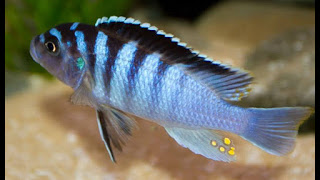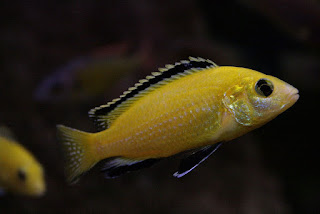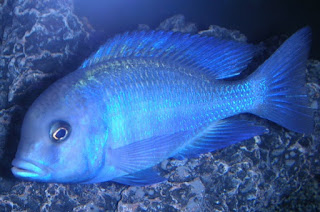Afra cichlid
The Dogtooth Cichlid Cynotilapia afra (previously Paratilapia afra) is a favorite for many cichlid aquarists because of their beautiful color patterns. They come in a variety of natural variations, depending on where they originate from, and can also change color depending on mood. The "excited" spawning colors of these Mbunas are very intense and make quite an interesting display.
This fish has many of the same wonderful qualities found in other African cichlids, but as its name suggests it is identified and distinguished because of its teeth. Its teeth are unicuspid rather than the bicuspid teeth seen in many cichlids of this size. The common name "dogtooth cichlid" is derived from its distinctive teeth. This is unique to just this genus and is a distinction sets it apart from all the other Lake Malawi Mbunas. In fact, in the genus name Cynotilapia the term 'Cyno' means 'dog' in latin. From its species name are derived the common names Afra Cichlid, Red Top Afra, and White Top Afra.
The Cynotilapia fish have a velvet richness to their coloration, and are very much like a the Melanochromis genus in both size and appearance. Though not really dwarf cichlids, these are all small sized African cichlids with attractive patternings. Some of these closely related Mbunas include the Auratus Cichlid M. auratus, Electric Blue Johanni M. johannii, and the Maingano M. cyaneorhabdos. Except for its teeth, he Dogtooth Cichlidalso very much like a smaller version of the Pseudotropheus and Maylandia zebra type cichlids. Some good examples are the Kenyi Cichlid M. lombardoi, Red Zebra Cichlid M. estherae, Bumblebee Mouthbrooder P. crabro, and Demanson's Cichlid P. demasoni.
The basic coloration of the male C. afra is a light blue with 7 strong black crossbands and eggspots on the anal fin, with the female being more of a blue-gray to slate gray. There are also many different color morphs and varieties in lavender, blue, light blue, yellow and everything in between. They can also have different coloring on the top band of their dorsal fin and some will have more bars than others. Interestingly, their vertical bars come and go depending on mood. Most males can turn their head and back coloring into an intense yellow gold as well, but even that depends on mood too.
This cichlid is generally easy to care for as long as its housing and dietary needs are met. A minimum 26 gallons would be needed for a pair. This fish is actually best kept in a small group however, and 55 gallon tank is necessary for harems consisting of one male and 3 females. An even larger aquarium will be needed if keeping it in a mixed cichlid community.
This is a robust species but it is territorial and will become quite quarrelsome, usually during spawning time. They can be kept with other Mbuna cichlids that are a little bigger, yet peaceful. Provide lots of passageways and caves formed with piles of rocks and robust vegetation. They will not bother tough plants. They eat a wide variety of foods and are typically easy to breed. Avoid cross breeding with similar cichlids to keep the strains pure. It is thought that even in the wild these fish hybridize.
Share - Support - Subscribe
Facebook : https://www.facebook.com/livingartaquarium.in
Instagram : https://www.instagram.com/livingartaquarium.in
Website : https://www.livingartaquarium.in
Email : meeranaquarist@gmail.com
G Plus : https://plus.google.com/114891881397071716394
Twitter : https://twitter.com/LivingArtAqua
Blog : http://livingartaquarium.blogspot.in/












Comments
Post a Comment